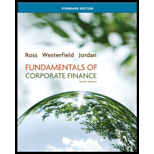
To determine: The projected dividend for the upcoming year.
Introduction:
Dividend is a sum of money paid to the shareholders of the company. It is distributed among the investors from the portion of a company’s earnings.
Answer to Problem 19QP
The projected dividend for the future year is $1.82.
Explanation of Solution
Given information:
F Company has sold stock for $76 per share. The required
The formula to calculate dividends of “n” number of Years:
Where,
Dnrefers to the dividend paid in “n” number of years
Do refers to the current year dividend paid
n refers to the number of years
g refers to the constant dividend’s growth rate
The formula to calculate current dividends using current stock price formula:
Where,
Po refers to the price of the stock of the current year
Do refers to the current year dividend paid
R refers to the required rate of return on its stock
g1refers to the expected growth
g2 refers to the constant rate of growth in the second year
g3 refers to the constant rate of growth in the third year
gn refers to the constant rate of growth in n number of year
n refers to the number of years
The formula to calculate projected dividend for the next year:
Where,
Do refers to the current year dividend paid
g1refers to the expected growth rate of dividend
D1 refers to the dividend payable in the future year
Compute the dividends in Year 3:
Hence, the dividends in Year 3 is (Do × 1.30)3. Consider this as Equation (1).
Compute the dividend in Year 4:
Hence, the dividends in Year 4 is (Do × 1.30)3 (1.20). Consider this as Equation (2).
As the stocks starts growing at a constant growth rate in Year 4, determine the stock price for the Year 4. The formula to calculate stock price for the Year 4 is given below: [Consider this formula as Equation (3)]
Where,
Porefers to the present price of a stock
D4refers to the dividend per share in Year 4
Rrefers to the required return on the stock
g refers to the constant dividend’s growth rate
Substitute Equation (2) in Equation (3) and simplify it into the simplest form as shown below:
Hence, the stock price in Year 4 is Do× 69.86.
Compute the current dividends using current stock price formula:
Hence, the current dividend is $1.40.
Compute the projected dividend for the next year:
Hence, the projected dividend for the future year is $1.82.
Want to see more full solutions like this?
Chapter 8 Solutions
Fundamentals of Corporate Finance Standard Edition
- Ends Mar 30 Discuss in detail what is Free Cash Flows and how is it calculated. Also define what is a Sunk Cost as well as an Opportunity Cost. 0arrow_forwardSubscribe Explain in detail what is a firm's Capital Structure? What is and how does a firm's Financial Policy impact its Capital Structure? Finally, what is opportunity costs and how does it affect a firm's Capital Structure?arrow_forwardWhat is the answer of this finance wuarrow_forward
 Essentials Of InvestmentsFinanceISBN:9781260013924Author:Bodie, Zvi, Kane, Alex, MARCUS, Alan J.Publisher:Mcgraw-hill Education,
Essentials Of InvestmentsFinanceISBN:9781260013924Author:Bodie, Zvi, Kane, Alex, MARCUS, Alan J.Publisher:Mcgraw-hill Education,

 Foundations Of FinanceFinanceISBN:9780134897264Author:KEOWN, Arthur J., Martin, John D., PETTY, J. WilliamPublisher:Pearson,
Foundations Of FinanceFinanceISBN:9780134897264Author:KEOWN, Arthur J., Martin, John D., PETTY, J. WilliamPublisher:Pearson, Fundamentals of Financial Management (MindTap Cou...FinanceISBN:9781337395250Author:Eugene F. Brigham, Joel F. HoustonPublisher:Cengage Learning
Fundamentals of Financial Management (MindTap Cou...FinanceISBN:9781337395250Author:Eugene F. Brigham, Joel F. HoustonPublisher:Cengage Learning Corporate Finance (The Mcgraw-hill/Irwin Series i...FinanceISBN:9780077861759Author:Stephen A. Ross Franco Modigliani Professor of Financial Economics Professor, Randolph W Westerfield Robert R. Dockson Deans Chair in Bus. Admin., Jeffrey Jaffe, Bradford D Jordan ProfessorPublisher:McGraw-Hill Education
Corporate Finance (The Mcgraw-hill/Irwin Series i...FinanceISBN:9780077861759Author:Stephen A. Ross Franco Modigliani Professor of Financial Economics Professor, Randolph W Westerfield Robert R. Dockson Deans Chair in Bus. Admin., Jeffrey Jaffe, Bradford D Jordan ProfessorPublisher:McGraw-Hill Education





